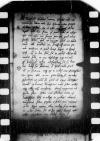Ostendit mihi dominus Jan Zambocki (*ca. 1480 – †1529), royal courtier, from 1527 a paid informer of Duke Albrecht von Hohenzollern at the royal court in Cracow. Together with Ioannes Dantiscus and Mikołaj Nipszyc, he formed the "triumvirate" of friends who were the front runners of a group of courtiers known for their fondness for entertainment; 1503 scribe in the royal chancellery; 1528 royal secretary; 1511 royal envoy to Masovia; 1519, 1526, 1527 - to Warmia and the Prussian Estates (WYCZAŃSKI 1990, p. 271; ORACKI 1988, p. 220-221)⌊ZamboczkiJan Zambocki (*ca. 1480 – †1529), royal courtier, from 1527 a paid informer of Duke Albrecht von Hohenzollern at the royal court in Cracow. Together with Ioannes Dantiscus and Mikołaj Nipszyc, he formed the "triumvirate" of friends who were the front runners of a group of courtiers known for their fondness for entertainment; 1503 scribe in the royal chancellery; 1528 royal secretary; 1511 royal envoy to Masovia; 1519, 1526, 1527 - to Warmia and the Prussian Estates (WYCZAŃSKI 1990, p. 271; ORACKI 1988, p. 220-221)⌋ litteras Vestras, quibus fortunas vestras queri et deplorare videmini. Eas cum potui non sine superinscribed⌈sinesine superinscribed⌉ magno dolore legere. Verum cum sciam id, quod actum est vobiscum esse nec iussu, nec scientia Bona Sforza (*1494 – †1557), Queen of Poland and Grand Duchess of Lithuania (1518-1557); the second wife of Sigismund I Jagiellon; Duchess of Bari and Rossano; daughter of Gian Galeazzo Sforza of Milan and Isabella of Aragon⌊principisBona Sforza (*1494 – †1557), Queen of Poland and Grand Duchess of Lithuania (1518-1557); the second wife of Sigismund I Jagiellon; Duchess of Bari and Rossano; daughter of Gian Galeazzo Sforza of Milan and Isabella of Aragon⌋, quid aliud suadere debeam, quam ut veniatis, nihil enim dubito omnia vobis persolutum iri.
Feratis aequo animo pro vestra prudentia id, quod bonis praecipue et dignis viris, non in hac solum, sed in omnibus aliis aulis accidere solet, et non despondeatis mox animum ex huiusmodi aulicis adversitatibus, sed, cum locus hic ludus sit fortunae, si quid cadit, quod non ex sententia neque ex re videtur, arte est corrigendum.
De Piotr Tomicki (*1464 – †1535), humanist, statesman, diplomat, one of the most trusted collaborators of King Sigismund I of Poland; 1500-1503 Chancellor of Cardinal Fryderyk Jagiellon, 1502 Gniezno Cantor, Archdeacon of Cracow, 1503-1505 servant of Jan Lubrański, Bishop of Poznań, 1504-1510 Canon of Poznań, 1506 royal scribe, 1507-1519 Grand(?) Secretary, 1509 Canon of Włocławek, 1510-1514 - of Gniezno, 1511 Custos in Kielce and Sandomierz, 1514 Bishop of Przemyśl; 1515 Crown Vice-Chancellor, 1520 Bishop of Poznań, 1523 - of Cracow; from 1524 (at least) General Collector of świętopietrze (Peter's pence), 1509 royal envoy to the Dukes of Pomerania and to Mecklenburg, 1510 - to Wallachia, 1510, 1511, 1512, 1513 - to Hungary (WYCZAŃSKI 1990, p. 268)⌊reverendissimo dominoPiotr Tomicki (*1464 – †1535), humanist, statesman, diplomat, one of the most trusted collaborators of King Sigismund I of Poland; 1500-1503 Chancellor of Cardinal Fryderyk Jagiellon, 1502 Gniezno Cantor, Archdeacon of Cracow, 1503-1505 servant of Jan Lubrański, Bishop of Poznań, 1504-1510 Canon of Poznań, 1506 royal scribe, 1507-1519 Grand(?) Secretary, 1509 Canon of Włocławek, 1510-1514 - of Gniezno, 1511 Custos in Kielce and Sandomierz, 1514 Bishop of Przemyśl; 1515 Crown Vice-Chancellor, 1520 Bishop of Poznań, 1523 - of Cracow; from 1524 (at least) General Collector of świętopietrze (Peter's pence), 1509 royal envoy to the Dukes of Pomerania and to Mecklenburg, 1510 - to Wallachia, 1510, 1511, 1512, 1513 - to Hungary (WYCZAŃSKI 1990, p. 268)⌋ et, me quantuluscumque sum, ita vobis persuadeatis, ut nihil sit, quod non aeque ad vest written over ...⌈... illegible⌈...... illegible⌉vestvest written over ...⌉rum commodum et honorem. Libentissime omnia praestare vellemus atque ullius nostri necessarii. Plenus occupatione non scribo plura.
Prussia, region in central Europe, bordered by Pomerania, Poland, Lithuania and Livonia. From 1466 Prussia was divided into Royal Prussia (Prussia Regalis), which was a part of the Kingdom of Poland, and Teutonic Prussia (Prussia Ordinis Theutonici) – covering the remnants of the former territory of the Teutonic Order’s state in Prussia. In 1525, the Order’s last Grand Master, Albrecht von Hohenzollern, converted to Lutheranism and became the first lay duke in former Teutonic Prussia (dux in Prussia), which from then on was called Ducal Prussia (Prussia Ducalis). At that time, as a result of the treaty of Cracow, Ducal Prussia became a fief of the kings of Poland⌊PatriaPrussia, region in central Europe, bordered by Pomerania, Poland, Lithuania and Livonia. From 1466 Prussia was divided into Royal Prussia (Prussia Regalis), which was a part of the Kingdom of Poland, and Teutonic Prussia (Prussia Ordinis Theutonici) – covering the remnants of the former territory of the Teutonic Order’s state in Prussia. In 1525, the Order’s last Grand Master, Albrecht von Hohenzollern, converted to Lutheranism and became the first lay duke in former Teutonic Prussia (dux in Prussia), which from then on was called Ducal Prussia (Prussia Ducalis). At that time, as a result of the treaty of Cracow, Ducal Prussia became a fief of the kings of Poland⌋ vestra fluctuat acriter ex Lutheranismo, fides et religio in exulatum abierunt. Immigravit seditio, perfidia et studium rerum novarum. Sigismund I Jagiellon (Zygmunt I) (*1467 – †1548), King of Poland and Grand Duke of Lithuania (1506-1548); Duke of Głogów (Glogau) (1499-1506), Duke of Opava (1501-1506), Governor of Silesia (1504-1506); son of King Kazimierz IV Jagiellon and Elisabeth of Austria⌊Maiestas regiaSigismund I Jagiellon (Zygmunt I) (*1467 – †1548), King of Poland and Grand Duke of Lithuania (1506-1548); Duke of Głogów (Glogau) (1499-1506), Duke of Opava (1501-1506), Governor of Silesia (1504-1506); son of King Kazimierz IV Jagiellon and Elisabeth of Austria⌋ cogitur illuc aulicos suos mittere et militem scribere. Sed de his coram latius.
Optime valete.


 BCz, 243, p. 72
BCz, 243, p. 72